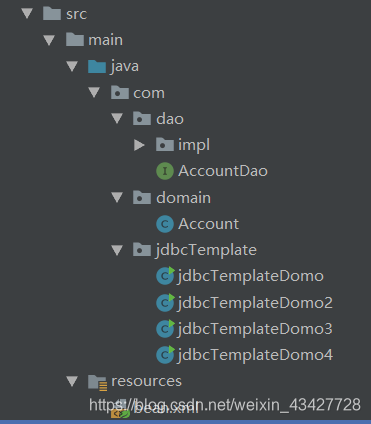使用spring自带的持久化jdbcTemplate,使用spring的声明式事务控制,xml实现,注解实现,纯注解实现
spring中的jdbcTemplate
<?xml version="1.0" encoding="UTF-8"?>
<project xmlns="http://maven.apache.org/POM/4.0.0"
xmlns:xsi="http://www.w3.org/2001/XMLSchema-instance"
xsi:schemaLocation="http://maven.apache.org/POM/4.0.0 http://maven.apache.org/xsd/maven-4.0.0.xsd">
<modelVersion>4.0.0</modelVersion>
<groupId>com</groupId>
<artifactId>springJDBCTemplate</artifactId>
<version>1.0-SNAPSHOT</version>
<packaging>jar</packaging>
<dependencies>
<dependency>
<groupId>org.springframework</groupId>
<artifactId>spring-context</artifactId>
<version>5.0.2.RELEASE</version>
</dependency>
<dependency>
<groupId>org.springframework</groupId>
<artifactId>spring-test</artifactId>
<version>5.0.2.RELEASE</version>
</dependency>
<dependency>
<groupId>mysql</groupId>
<artifactId>mysql-connector-java</artifactId>
<version>5.1.6</version>
</dependency>
<dependency>
<groupId>org.springframework</groupId>
<artifactId>spring-jdbc</artifactId>
<version>5.0.2.RELEASE</version>
</dependency>
</dependencies>
</project>
引入spring-jdbc依赖,然后创建数据库表和对应的实体类

在bean.xml中将数据源,jdbcTemplate和AccountDao注入
<?xml version="1.0" encoding="UTF-8"?>
<beans xmlns="http://www.springframework.org/schema/beans"
xmlns:xsi="http://www.w3.org/2001/XMLSchema-instance"
xsi:schemaLocation="http://www.springframework.org/schema/beans
http://www.springframework.org/schema/beans/spring-beans.xsd">
<!--如果dao类注解继承了JdbcDaoSupport就不需要注入jdbcTemplate了,直接注入数据源 -->
<bean id="accountDao" class="com.dao.impl.AccountDaoImpl">
<!--<property name="jd" ref="jdbcTemplate"></property>-->
<property name="dataSource" ref="dataSource"></property>
</bean>
<!--配置jdbcTemplate-->
<bean id="jdbcTemplate" class="org.springframework.jdbc.core.JdbcTemplate">
<property name="dataSource" ref="dataSource"></property>
</bean>
<!--配置数据源-->
<bean id="dataSource" class="org.springframework.jdbc.datasource.DriverManagerDataSource">
<property name="driverClassName" value="com.mysql.jdbc.Driver"></property>
<property name="url" value="jdbc:mysql://localhost:3306/eesy"></property>
<property name="username" value="root"></property>
<property name="password" value="123456"></property>
</bean>
</beans>
如果dao类注解继承了JdbcDaoSupport就不需要注入jdbcTemplate了,JdbcDaoSupport能够得到jdbcTemplate对象,直接使用getJdbcTemplate()方法
public class AccountDaoImpl extends JdbcDaoSupport implements AccountDao {
public void insert(Integer id) {
getJdbcTemplate().update("insert into account(name,money) value ('123',123456)");
}
public void delete(Integer id) {
getJdbcTemplate().update("delete from account where id = ?",id);
}
public Account selectAccountById(Integer id) {
List<Account> accounts = getJdbcTemplate().query("select * from account where id = ?",new BeanPropertyRowMapper<Account>(Account.class),id);
return accounts.isEmpty()?null:accounts.get(0);
}
public List<Account> selectAll() {
List<Account> accounts = getJdbcTemplate().query("select * from account",new BeanPropertyRowMapper<Account>(Account.class));
return accounts;
}
}
这里继承JdbcDaoSupport 是因为当我们的dao很多的时候,每个都需要注入jdbcTemplate,造成了许多的代码的冗余。
从spring容器中获得jdbcTemplate,实现插入操作。
public class jdbcTemplateDomo2 {
public static void main(String[] args) {
ApplicationContext ac = new ClassPathXmlApplicationContext("bean.xml");
JdbcTemplate jd = (JdbcTemplate) ac.getBean("jdbcTemplate",JdbcTemplate.class);
jd.execute("insert into account(name,money) value('iii',1000)");
}
}
这里需要注意的就是查询一个和查询所有的实现,可以使用RowMapper()方法来实现数据的封装
public class JdbcTemplateDemo3 {
public static void main(String[] args) {
//1.获取 Spring 容器
ApplicationContext ac = new ClassPathXmlApplicationContext("bean.xml");
//2.根据 id 获取 bean 对象
JdbcTemplate jt = (JdbcTemplate) ac.getBean("jdbcTemplate");
//3.执行操作
//查询所有
List<Account> accounts = jt.query("select * from account where money > ? ",
new AccountRowMapper(), 500);
for(Account o : accounts){
System.out.println(o);
}
}
}
//通过实现RowMapper()接口来封装数据
public class AccountRowMapper implements RowMapper<Account>{
public Account mapRow(ResultSet rs, int rowNum) throws SQLException {
Account account = new Account();
account.setId(rs.getInt("id"));
account.setName(rs.getString("name"));
account.setMoney(rs.getFloat("money"));
return account;
}
}
但是spring提供了BeanPropertyRowMapper(T.class)方法,来帮助我们封装数据
查询一个直接返回第一个即可
//查询所有
List<Account> accounts = jd.query("select * from account where money > ?",new BeanPropertyRowMapper<Account>(Account.class),1001f);
for(Account account:accounts)
{
System.out.println(account);
}
//查询一个
List<Account> accounts = jd.query("select * from account where id = ?",new BeanPropertyRowMapper<Account>(Account.class),3);
System.out.println(accounts.isEmpty()?"为空":accounts.get(0));
spring声明式事务
转账功能在spring第三天AOP(上)中,通过自定义一个工具类实现事务又或者是使用工厂类实现,到最后通过AOP面向切面,连工厂类都免了,其实spring有提供声明式事务,只需在bean.xml配置文件中配置一下就实现了事务功能。
- spring中基于XML的声明式事务控制配置步骤
1、配置事务管理器
2、配置事务的通知
此时我们需要导入事务的约束 tx名称空间和约束,同时也需要aop的
使用tx:advice标签配置事务通知
属性:
id:给事务通知起一个唯一标识
transaction-manager:给事务通知提供一个事务管理器引用
3、配置AOP中的通用切入点表达式
4、建立事务通知和切入点表达式的对应关系
5、配置事务的属性
是在事务的通知tx:advice标签的内部
引入带有xmlns:tx的依赖
<?xml version="1.0" encoding="UTF-8"?>
<beans xmlns="http://www.springframework.org/schema/beans"
xmlns:xsi="http://www.w3.org/2001/XMLSchema-instance"
xmlns:aop="http://www.springframework.org/schema/aop"
xmlns:tx="http://www.springframework.org/schema/tx"
xsi:schemaLocation="
http://www.springframework.org/schema/beans
http://www.springframework.org/schema/beans/spring-beans.xsd
http://www.springframework.org/schema/tx
http://www.springframework.org/schema/tx/spring-tx.xsd
http://www.springframework.org/schema/aop
http://www.springframework.org/schema/aop/spring-aop.xsd">
<bean id="accountService" class="com.service.impl.AccountServiceImpl">
<property name="accountDao" ref="accountDao"></property>
</bean>
<!-- 配置账户的持久层-->
<bean id="accountDao" class="com.dao.impl.AccountDaoImpl">
<property name="dataSource" ref="dataSource"></property>
</bean>
<!-- 配置数据源-->
<bean id="dataSource" class="org.springframework.jdbc.datasource.DriverManagerDataSource">
<property name="driverClassName" value="com.mysql.jdbc.Driver"></property>
<property name="url" value="jdbc:mysql://localhost:3306/eesy"></property>
<property name="username" value="root"></property>
<property name="password" value="123456"></property>
</bean>
<!-- 1.配置事务管理器-->
<bean id="tsManager" class="org.springframework.jdbc.datasource.DataSourceTransactionManager">
<property name="dataSource" ref="dataSource"></property>
</bean>
<!-- 2、配置事务的通知-->
<tx:advice id="txAdvice" transaction-manager="tsManager">
<!-- 5.配置事务的属性
isolation:用于指定事务的隔离级别。默认值是DEFAULT,表示使用数据库的默认隔离级别。
propagation:用于指定事务的传播行为。默认值是REQUIRED,表示一定会有事务,增删改的选择。查询方法可以选择SUPPORTS。
read-only:用于指定事务是否只读。只有查询方法才能设置为true。默认值是false,表示读写。
timeout:用于指定事务的超时时间,默认值是-1,表示永不超时。如果指定了数值,以秒为单位。
rollback-for:用于指定一个异常,当产生该异常时,事务回滚,产生其他异常时,事务不回滚。没有默认值。表示任何异常都回滚。
no-rollback-for:用于指定一个异常,当产生该异常时,事务不回滚,产生其他异常时事务回滚。没有默认值。表示任何异常都回滚。
-->
<tx:attributes>
<!--spring事务传播属性
在 spring的 TransactionDefinition接口中一共定义了六种事务传播属性:
PROPAGATION_REQUIRED -- 支持当前事务,如果当前没有事务,就新建一个事务。这是最常见的选择。
PROPAGATION_SUPPORTS -- 支持当前事务,如果当前没有事务,就以非事务方式执行。
PROPAGATION_MANDATORY -- 支持当前事务,如果当前没有事务,就抛出异常。
PROPAGATION_REQUIRES_NEW -- 新建事务,如果当前存在事务,把当前事务挂起。
PROPAGATION_NOT_SUPPORTED -- 以非事务方式执行操作,如果当前存在事务,就把当前事务挂起。
PROPAGATION_NEVER -- 以非事务方式执行,如果当前存在事务,则抛出异常。
PROPAGATION_NESTED -- 如果当前存在事务,则在嵌套事务内执行。如果当前没有事务,则进行与PROPAGATION_REQUIRED类似的操作。 -->
<tx:method name="*" propagation="REQUIRED" read-only="false"/>
<tx:method name="find" propagation="SUPPORTS" read-only="true"></tx:method>
</tx:attributes>
</tx:advice>
<aop:config>
<!-- 3、配置AOP中的通用切入点表达式-->
<aop:pointcut id="pt1" expression="execution(* com.service.impl.*.*(..))"></aop:pointcut>
<!-- 4、建立事务通知和切入点表达式的对应关系-->
<aop:advisor advice-ref="txAdvice" pointcut-ref="pt1"></aop:advisor>
</aop:config>
</beans>
基于注解的声明式事务
要引入注解的依赖
bean.xml
<?xml version="1.0" encoding="UTF-8"?>
<beans xmlns="http://www.springframework.org/schema/beans"
xmlns:xsi="http://www.w3.org/2001/XMLSchema-instance"
xmlns:aop="http://www.springframework.org/schema/aop"
xmlns:context="http://www.springframework.org/schema/context"
xmlns:tx="http://www.springframework.org/schema/tx"
xsi:schemaLocation="
http://www.springframework.org/schema/beans
http://www.springframework.org/schema/beans/spring-beans.xsd
http://www.springframework.org/schema/tx
http://www.springframework.org/schema/tx/spring-tx.xsd
http://www.springframework.org/schema/aop
http://www.springframework.org/schema/aop/spring-aop.xsd
http://www.springframework.org/schema/context
http://www.springframework.org/schema/context/spring-context.xsd">
<context:component-scan base-package="com.itheima"></context:component-scan>
<bean id="jdbcTemplate" class="org.springframework.jdbc.core.JdbcTemplate">
<property name="dataSource" ref="dataSource"></property>
</bean>
<!-- 配置数据源-->
<bean id="dataSource" class="org.springframework.jdbc.datasource.DriverManagerDataSource">
<property name="driverClassName" value="com.mysql.jdbc.Driver"></property>
<property name="url" value="jdbc:mysql://localhost:3306/eesy"></property>
<property name="username" value="root"></property>
<property name="password" value="123456"></property>
</bean>
<!-- 配置事务管理器 -->
<bean id="transactionManager" class="org.springframework.jdbc.datasource.DataSourceTransactionManager">
<property name="dataSource" ref="dataSource"></property>
</bean>
<!--开启spring对注解事务的支持 -->
<tx:annotation-driven transaction-manager="transactionManager"></tx:annotation-driven>
</beans>
然后在service实现类中加@Transactional即可实现
@Service("accountService")
@Transactional
public class AccountServiceImpl implements IAccountService{
@Autowired
private IAccountDao accountDao;
public Account findAccountById(Integer accountId) {
return accountDao.findAccountById(accountId);
}
//需要的是读写型事务配置
public void transfer(String sourceName, String targetName, Float money) {
System.out.println("transfer....");
//2.1根据名称查询转出账户
Account source = accountDao.findAccountByName(sourceName);
//2.2根据名称查询转入账户
Account target = accountDao.findAccountByName(targetName);
//2.3转出账户减钱
source.setMoney(source.getMoney()-money);
//2.4转入账户加钱
target.setMoney(target.getMoney()+money);
//2.5更新转出账户
accountDao.updateAccount(source);
int i=1/0;
//2.6更新转入账户
accountDao.updateAccount(target);
}
}
dao中的Repository注解和注入的注解略

